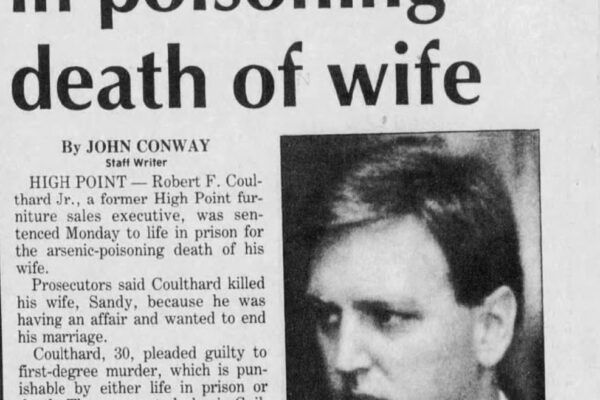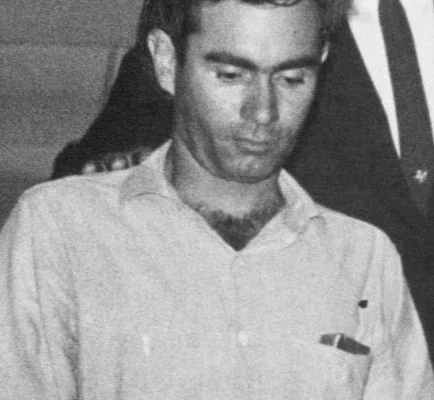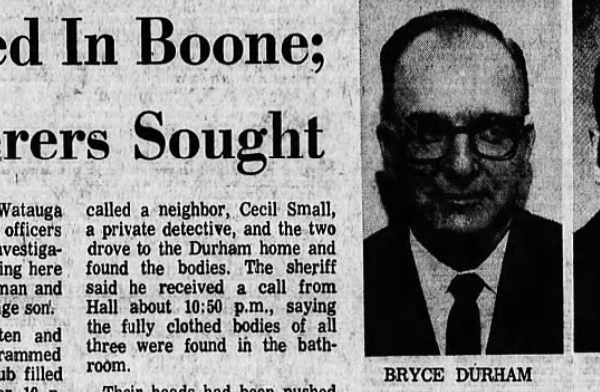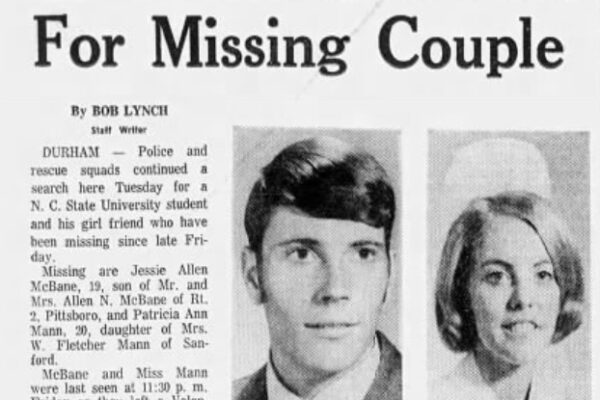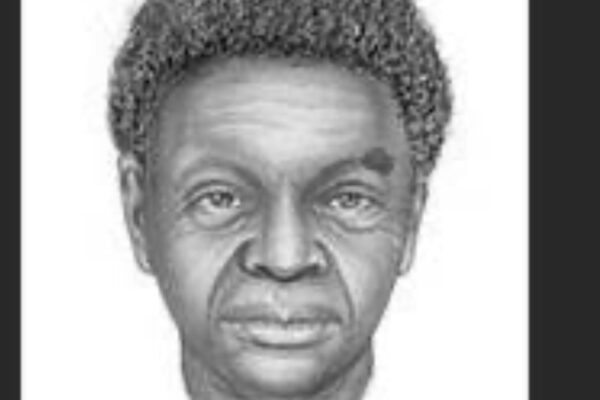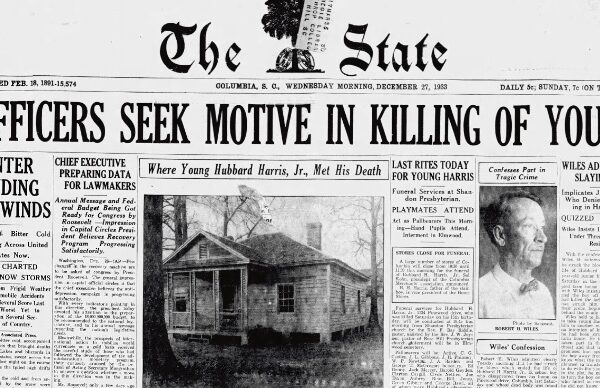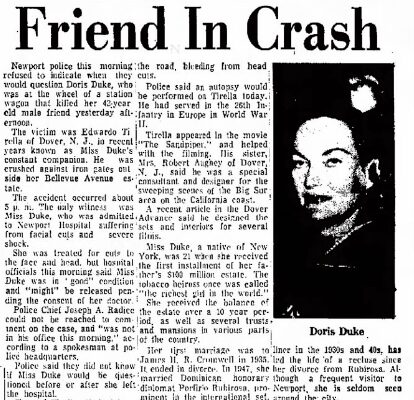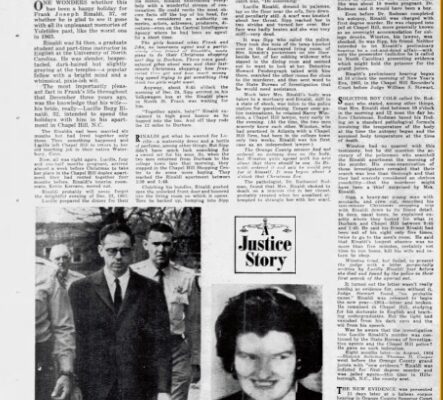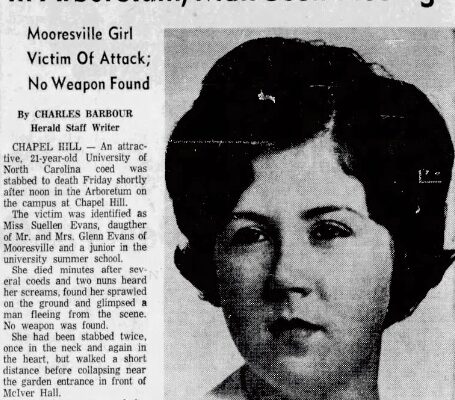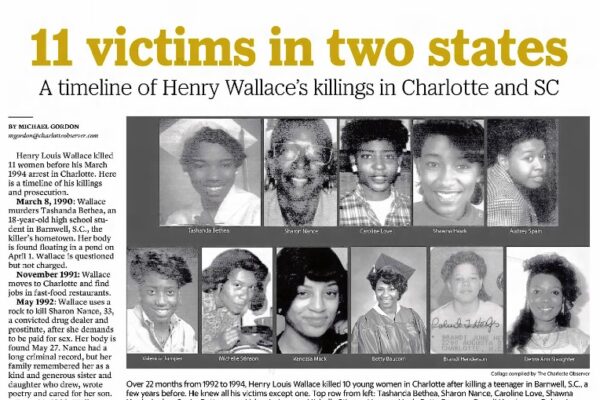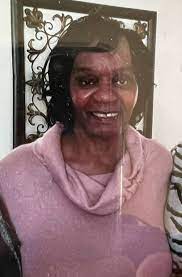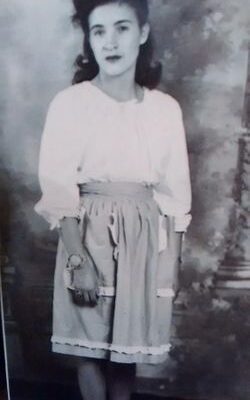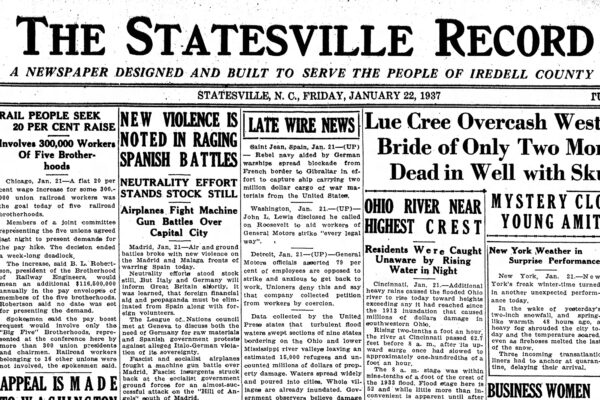In episode 32, “Missing Teen Girls in North Carolina,” I shared the story a young woman named Sherri Lee Truesdale. Sherri’s story is another one of those cases that doesn’t have a lot of background information because she went missing such a long time ago, but family members have not given up on the idea of resolution.
On June 13, 1970, 14-year-old Sherri left her home in Winston-Salem around 11:30 a.m. and took the bus to a local shopping mall to purchase school supplies. Sherri, who was described by those who knew her as a quiet, studious young woman, had won a scholarship to attend a summer fine arts program at Mount Tabor High School, which is why she needed to buy supplies. While she was out, she planned to go by Rayless Department Store to make a payment on the charge account her mother had there and buy some doughnuts for her older sister, Ernestine. A clerk at Rayless later reported seeing Sherri around 4:30 p.m. that day. She never arrived home.
Because this was out of character for Sherri, her parents reported her missing the next day. According to media reports, investigators launched a six-week search of the Winston-Salem area, including nearby Happy Hill Park, which was just a few blocks away from Sherri’s home. There was a heavy rainstorm the night Sherri went missing, and one of the theories was that Sherri had accidentally drowned in one of the creeks at the park while on her way home, but no evidence was ever uncovered to support this. There were never any other reported sightings of Sherri after the clerk from the department store, and in May 2013, Sherri’s older sister Ernestine Chambers told The Charlotte Observer they were still hoping they could find out what happened. In the article she mentioned that their mother had looked at the bus stop near their home every day after Sherri disappeared, hoping she would get back off the bus and return home one day.
Sherri Lee Truesdale is an African American female who stood four feet two inches tall when she went missing. She has brown eyes and black hair. She has a mole above her upper lip and on the base of her neck. When she was last seen, she was wearing a blue shirt, blue bell bottom pants, brown loafers, and pentagon-shaped aqua blue earrings. Anyone with information on this case should call the Winston Salem Police Department at 336-773-7848.
I shared Eva Debruhl’s story on Episode 20, “Missing from the Front Yard.” On June 29, 1977, 15-year-old Eva disappeared from her front yard in a small town outside of Rock Hill, South Carolina. It was a hot day when Eva set about doing her regular chore of mowing her family’s yard. Her dad, a mechanic named Willard, had headed off on a job around 11 a.m. Eva’s mother Opal, a third shift worker, was asleep inside the family’s home. When Willard Debruhl returned home around 4 p.m., Eva was nowhere to be found. Her older sister Tammy said Eva hadn’t been home when she returned from her job at a local textile mill. She hadn’t walked over to eat lunch with her grandmother, who lived in a separate home on the family’s 9-acre property. Eva’s rubber flip flops she had worn that morning were on the front lawn, and a pot of iced tea and a glass were inside the house on the kitchen counter.
A Perplexing Disappearance
When Eva’s family searched the home, her room was exactly as they had left it. All her clothes were in her closet, her $54 in babysitting money she had saved still in her purse, and the television was left on in the living room, a chair reclined as if someone had been there watching a program. When they talked to Eva’s grandmother, she mentioned she had seen a man in a blue or green truck with a white top drive onto the property and knock on the front door before Eva must have gone missing. The grandmother didn’t think anything of the visitor because Willard was a mechanic and people often stopped by for help with their vehicles. A man got out of the truck, appeared to knock on the front door and then drove off. The grandmother said he returned in the truck about 10 minutes later, and then she got busy inside of her house and lost track of him. She didn’t know if he had gotten out of the truck on the second visit. She described this man an as a white male with a medium height and build. He was wearing a light green shirt and dark green pants. The family later found a glass Coke bottle in the yard next to where the truck had been parked, and it didn’t seem to belong to anyone there. The man and this truck were never identified, and it wasn’t clear whether he had any connection to Eva’s disappearance or not.
For the most part, Eva, who was planning on attending Rock Hill High School that fall, was described by her family as a homebody who mostly spent her spare time babysitting local children and singing in the church choir. They didn’t believe she had run away, especially since she hadn’t taken anything with her. She likely wasn’t even wearing shoes.
At the time of her disappearance, Eva was a petite girl standing about five foot two and weighing approximately 105 pounds. She had long, straight blonde hair with bangs, blue eyes and wore eyeglasses. She was wearing a pink floral print sweater and light-blue floral print shorts the last time her family members saw her. Anyone with information on her case is asked to contact the York County Sheriff’s Department at 803-628-3059.
Next, I’d like to talk about Galvin and Garry Sidden Jr., two young brothers who went missing on July 21, 1982 from the rural community of Traphill in North Carolina. I discussed this disappearance in Episode 36, “Missing from Wilkes County.” On the evening of their disappearance, the boys’ father, Garry Patrick Sidden, a local store owner, was shot twice with a shotgun outside of their mobile home. His two sons, Galvin, who was 10 years old, and Garry Jr., who was 15, were nowhere to be found after the shooting. Investigators found a pair of orthopedic shoes belonging to Garry Jr. about a half mile from the crime scene. The boy needed the shoes to keep his hip in place after an accident he’d been in a few years earlier.
A Deadly Family Feud
The two people suspected in Garry Senior’s murder, Tony Sidden, who from some reports was a cousin by marriage, and his stepson Anthony Ray Blankenship, could not be found in the days following Garry Senior’s death. No one knew where the boys had gone, but it didn’t look good. From what I read in a 1984 newspaper article that ran in The Charlotte Observer, the murder occurred as part of a family feud. Tony’s stepson Anthony, who was 15 at the time, got into some sort of argument with Galvin and Garry Junior and things escalated.
Tony and Anthony left the area before they could be questioned about the murder or the whereabouts of the two boys. After living in a few different states, they eventually turned themselves in and confessed to Garry Sidden’s murder in September of 1983. But they still would not give any information about the whereabouts of the Sidden sons at that time. Tony Sidden and Anthony Blankenship went on trial and were both convicted in the murder and sentenced to life in prison.
But still, the residents of Wilkes County wondered, where were the boys? Had they been murdered too? Could they still be alive? Finally, in September of 1991, residents in the Wilkes County community of Purlear watched as a man in shackles led investigators to an abandoned well. The man in shackles was Anthony Blankenship. He had finally decided to unburden himself and lead investigators to what was left of the two boys.
He said his stepfather Tony had planned to rob Garry Sidden Senior when he came back from working at a nightclub he owned. After parking their car on a logging road near the mobile home, they waited, armed with weapons. When Garry didn’t return, they walked up to the trailer and looked inside a window, where they saw Garry asleep on the couch. Not long after, the two sons arrived home, and they were forced into the mobile home with their father at gunpoint. After leading Garry Senior and his two sons outside, Tony Sidden wrestled over the shotgun he was carrying with Garry. He then shot Garry, in the neck, stealing his wallet and the $300 in it. Anthony said they then forced the two boys in the trunk of their car, and Anthony thought they were going to leave them in the woods somewhere until he and his stepfather could escape. He thought wrong.
What Really Happened to the Sidden Brothers
The two men drove for a bit before stopping the car on a dark country road. Tony ordered the two boys outside of the car, executed them, and then drove away. He and Anthony hid out in Spring Lake, near Fayetteville, for a few days. They came back, upon Tony’s request, and Anthony helped him retrieve the bodies of the Galvin and Garry Junior, taking them to an abandoned well on a piece of property his family had once lived on. They covered the bodies with lime and a few logs, before leaving the state. Anthony admitted he was armed when the two boys were killed, but decided there “was not much he could do at that point to save their lives.”
Anthony Blankenship received two consecutive life in prison terms for the murders of the two boys. Tony Sidden was convicted and sentenced to death, although he has filed a number of appeals over the years and remains on death row at the age of 77. In a July 18, 2011 article in the Journal Patriot, a North Carolina Supreme Court judge was quoted as saying, “We can only imagine the terror the two boys felt as they awaited their fate. The torture endured by these two children removes any doubt that the sentence of death in this case is proportionate,” when compared to other capital cases.
The disappearance of Jessica Gutierrez from Lexington, South Carolina devastated her family for years. I discussed it in Episode 14, “South Carolina Disappearances Featured on Unsolved Mysteries.” On June 6, 1986, four-year-old Jessica was sharing a bed with her older sister, who was six at the time, in the family’s mobile home. When Jessica’s mother Debra woke up the next morning, she went into the girls’ room to wake them up. She found her older daughter, Becky, school papers littered all over the floor, and no Jessica. The front door was also open and the family’s dog, who normally slept outside, was inside the house. Someone had ripped curtains off one of the windows. When Debra questioned Becky, she told her mother that a man with a “magic hat and beard” had taken Jessica out of the bed sometime during the night. She had been too afraid to call out for help when it happened and eventually fell back asleep.
Jessica’s father was separated from Debra and he lived on the West Coast at the time, which the police confirmed. One suspect in Jessica’s disappearance was an ex-boyfriend of Debra Gutierrez. She had broken things off with him because of possessive behavior and alcohol abuse just days before Jessica vanished in the night. Police questioned him but he was never charged.
No Ordinary Stranger Abduction
According to an article I found in The State newspaper, a family acquaintance stole a van in Lexington County, drove it to North Carolina and sexually assaulted a woman there. He was charged in the crime and later sent to prison. While this man was in prison, he allegedly told his cellmate that he had kidnapped a little girl in Lexington County while wearing what he called a tall cowboy hat. He told the cellmate he buried the little girl in a landfill in Lexington County, prompting a search of a landfill near the Gutierrez home. Investigators never found any signs of Jessica. The cellmate offered to testify against this family acquaintance in exchange for immunity, but the deal was denied. In the article mentioned above, a representative for the Lexington County Sheriff’s Department said they had reviewed all the evidence supplied by the informant, but didn’t feel they had sufficient evidence to proceed with the case.
The only evidence investigators found at the Gutierrez home following the kidnapping was a set of fingerprints found on a windowsill in the living room, which is apparently where the intruder entered the home. These fingerprints were matched to the family acquaintance who was convicted of sexually assaulting the woman in North Carolina. Debra Gutierrez has told reporters in the past that she believes her ex-boyfriend and the family acquaintance knew each other and may have worked together to abduct Jessica.
In fall of 2021, the Lexington County Sheriff announced they were revisiting Jessica’s case, interviewing more than 125 people and going through more than 3,000 case files. In January of 2022, police in North Carolina announced they’d arrested a man named Thomas Eric McDowell, then age 61, at his home about 20 miles north of Raleigh. He was charged with kidnapping, murder, and burglary in the case of Jessica Gutierrez. Authorities have said he was living in Lexington, South Carolina, at the time the little girl went missing in June 1986.
In an interview with The State newspaper in South Carolina published on January 8, 2022, Jessica’s mother Debra said she had long suspected Thomas McDowell of being involved. When he was convicted of sexual assault in 1987, his fingerprints taken matched a set of prints lifted from a window at the Gutierrez home after Jessica disappeared. She said Thomas was a distant acquaintance of the family, because his uncle had married Debra’s cousin. In February of 2023, a jury in Columbia, South Carolina found Thomas McDowell guilty of kidnapping and murdering Jessica Gutierrez in 1986.
The cellmate he’d once confessed to, Michael Fowler, testified for the prosecution. McDowell had told him he had killed a four-year-old girl, dismembered her body, and then buried her in 1986. He did not mention her by name in the confession. One of the key pieces of evidence was that fingerprint recovered from the girls’ bedroom window back when Jessica disappeared. It was a match to Thomas McDowell.
McDowell received two consecutive life sentences for the kidnapping and murder of Jessica Gutierrez.
Missing Real Estate Agent
Beaches, creeks, rivers, and lakes frequently feature prominently in summertime disappearances, and many have speculated that the murky depths of Lake Norman in North Carolina hold the key to what happened to Dianne Gabriel in 1983. Her story appeared in Episode 15, “Missing Real Estate Agents from North Carolina.”
Dianne was 38 years old when she went missing from Mooresville on July 18, 1983. According to her husband, Don, she had tried out several different professional careers before earning her real estate license right before the housing market crashed in the early 1980s. Still, she was motivated, and enjoyed her job with Century 21 Realty. On the day she disappeared, Don had traveled to Columbia, South Carolina for a business trip. Dianne had a few appointments with prospective buyers, and also told colleagues about an evening meeting she had to assess some lake property in Mooresville that was for sale. None of her colleagues were available to go with her to that appointment, as this was something they tried to do for safety reasons. Her colleagues assumed that Dianne went alone.
A Suspicious Appointment
When Don Gabriel returned home from his trip from Columbia two days later, he found no sign of Dianne or her car. He did a find a note in the trash with an address in Mooresville on it. The paper contained Dianne’s handwriting and listed an address for a three-bedroom house on Highway 150 in Mooresville, which would have been on Lake Norman. There was also a name, a phone number a mention of a green pickup truck. He contacted the authorities.
On July 20, police found Dianne’s car, a 1981 Buick Skylark, at a Mooresville restaurant called The Pier. Dianne’s briefcase and realty company signs were in the trunk. The passenger side window had been shattered. Dianne’s keys were also missing, and investigators could find no sign of fingerprints.
The week after Dianne’s car was found at the restaurant, volunteers searching for her found a suspicious trash bag in a ditch off Highway 150. The bag contained pornographic magazines, a roll of duct tape, some towels, nylon rope, plastic utensils, a ballpoint pen and a piece of duct tape that looked like it could have been used as a restraint.
In the months following Dianne’s disappearance, newspaper articles in The Charlotte Observer reported the mindset of the real estate community. In an article published on August 11, 1983, staff writer Bruce Henderson wrote:
“In a world of sunny yellow “For Sale” signs, where a firm handshake and a trustworthy demeanor are tools of the trade, danger seems as farfetched as a 7 percent mortgage. In the past month, however, Piedmont real estate agents, many of them women, have learned otherwise.”
The article went on to detail a few alarming incidents that had occurred since Dianne’s disappearance. On August 8, 1983, a real estate agent in nearby Lincoln County went to a home expecting to meet with a prospective buyer. When she arrived, she was confronted by a man wearing a ski mask and brandishing a handgun. After the man sexually assaulted the real estate agent, he left the home in her car. After this incident, authorities in Lincoln County made a public statement imploring female agents to go in pairs when meeting with unknown prospects, or send a male colleague instead.
Investigators didn’t think there a connection between the Lincoln County agent’s rape and the Dianne Gabriel case. It did seem like the Iredell County investigators had a lead on the Dianne Gabriel case on the August 8 article. Reporter Bruce Henderson noted that a few months before Dianne went missing, another female real estate agent had attempted to visit that same house in Mooresville on Lake Norman for an appraisal. She got spooked by some barking dogs and left. The owners of the house told authorities the house had never been for sale and that they had made no such appointments.
A latent print expert for the State Bureau of Investigation was able to lift fingerprints from the duct tape found by the volunteer and match them to a man named Johnny Joseph Head. He was a construction worker that lived about 25 minutes from where the bag had been found in Mooresville.
And, seven months after Dianne went missing, a man walking in snowy woods near Paradise Peninsula Road (where Dianne had been headed for that appointment) found more items related to the case. He came across her clothing, shoes, keys, purse and a notepad. These items were discovered near the McCrary Creek Access Area, which had been extensively searched after Dianne’s initial disappearance. Investigators were able to connect materials found in Head’s home to items of Dianne’s that were found in the woods.
A Controversial Court Case
He was arrested and charged with Dianne’s murder, although was later released on a $100,000 bond that his parents posted the money for. In a newspaper article announcing Head’s release on bail, an investigator with the Iredell County Sheriff’s Department gave a statement to reporter Kate Boylan. He said they had evidence Head had made an appointment with Dianne the evening she went missing. The address of his parents’ home was found in Dianne’s house on a piece of a paper. They also searched the Head home and found hair, fingerprints, a business card and a photograph they linked to Dianne. Based on what they found, authorities believe Head lured Gabriel to his home at Lake Norman, bound her hands and feet with duct tape and strangled her.
Twenty-eight-year-old Johnny Joseph Head went on trial in March of 1985, but as one Charlotte Observer article noted, the lack of a body complicated the job of the district attorney prosecuting the case. At that point, there was only one other known case in North Carolina of a person being convicted of murder with no evidence of a body. In 1860, a Rockingham County man named Robert T. Williams had been convicted of murdering Peggy Isley, although Peggy’s body had never been found.
Johnny Joseph Head was convicted of the second-degree murder of Dianne Gabriel, which meant the jury believed he killed Dianne with malice but not with premeditation and deliberation. He was sentenced to 50 years in prison. His attorney immediately filed an appeal, but the North Carolina Court of Appeals ruled in February of 1986 that the circumstantial evidence linking Head to the death of Dianne Gabriel was sufficient for conviction.
Head was released in 2001 after serving only sixteen years of his sentence. He continues to maintain his innocence in the case. Meanwhile, the body of Dianne Gabriel has never been found.
Following the Grateful Dead
Before everyone carried a cell phone, it was easy to get separated from friends during summer outings like ball games, festivals, or outdoor concerts. This appears to be what happened to a young man who went missing in Raleigh, North Carolina, on July 10, 1990. I first talked about this disappearance in Episode 21, “Missing After a Night Out.”
Douglas Simmons, a Florida college student who was 20 years old, had traveled to Carter-Finley Stadium with a few friends for a Grateful Dead concert. Those friends told Douglas’s father they had last seen him around 7 p.m., walking towards the woods beside the stadium’s parking lot. The band was about to take the main stage, and his friends thought he must have been heading to the car to retrieve something.
Around midnight, they called Douglas’s father because he had never made it back inside the stadium to the concert. Bobby Simmons at first thought maybe Douglas had decided to travel with the band to their remaining tour dates, which was something a lot of Grateful Dead fans had been known to do. Investigators didn’t think that was a plausible theory, though, because he could have just told his friends those plans. And why hadn’t he returned for the show he’d been looking forward to seeing? The group had also driven up to the concert from Pensacola, Florida and planned to head back home immediately following the show.
A few weeks after Douglas went missing, his father drove up from Florida to help participate in a search in the wooded area beside Carter-Finley Stadium. They found no sign of Douglas. Internet sleuths discussed this case for many years, because there have been scores of people who have gone missing or been murdered with ties to these Grateful Dead concerts.
Payne Lindsey and Jake Brennan created a whole podcast on this phenomenon called “Dead and Gone.” But as I was reading about Douglas, and trying to figure out if his case had ever been solved, I came across an obituary for him in a Florida newspaper that ran in 2018. Apparently, some bones and a wallet found in the woods just a few miles from Carter-Finley Stadium in 2016 were identified as belonging to Douglas.
It remains unclear whether he was under the influence of drugs or alcohol and got disoriented and injured while lost in the wooded area or he was met with foul play, but at the very least his family was able to get some closure as to where he had been all that time.
A Cold Case from Charlotte
And finally, I’d like to share a murder case from the summer of 2002 that remains unsolved.
In 2002, David Aaron Moore wrote a series of articles for Charlotte Creative Loafing about a colorful and charismatic fixture around Charlotte, Franklin Freeman, also known as “ReRe,” and those pieces eventually turned into a detailed chapter of his book, Charlotte: Murder, Mystery and Mayhem.
The gregarious 35-year-old Freeman loved people and animals, as evidenced by his work at a pet grooming salon called Posh Pets. But he was also a very unique individual who, by today’s terminology, would have been considered more comfortable described as gender fluid. Freeman enjoyed dressing in women’s clothing and performing as “Aretha Scott” while lip syncing Aretha Franklin’s R&B classics at Oleen’s, a gay bar that used to be located in Charlotte’s Dilworth neighborhood.
ReRe was found shot to death on June 7, 2002, at the corner of Church and Liddel streets in Charlotte. His death remains unsolved, but there are many in the community that believe ReRe’s death was an inside job and had to do with testimony he was supposed to participate in involving a sergeant with the Charlotte-Mecklenburg Police Department.
To understand the full story, we’ll have to go back to an evening five months before ReRe was fatally shot. On January 8, 2002, a Vice Detective with the police department named Michael Marlow finished a shift around 1:30 a.m. and headed up to the eighth floor of the policeman’s parking deck for an after hours drinking party. This was something that had apparently been going on for a while, but the administration allegedly chose to ignore it. About 45 minutes later, Marlow left the party in his unmarked patrol car. But instead of heading home, he headed to North Davidson Street, an area known for a heavy presence of prostitutes. This was an area ReRe frequented, where he would dress in women’s clothing and offer services to the johns who stopped by as a way to fund a drinking and drug habit he had developed.
It’s hard to know exactly what happened next, because both Michael Marlow and ReRe told conflicting stories. According to Marlow, ReRe jumped into his car and refused to get out unless Marlow gave him $20. An altercation followed and Marlowe fired his gun at ReRe and radioed for backup. Two officers, M.H. Mack and D.J. Aldridge responded to the scene, where they confronted ReRe after he had fled the scene and arrested him for assaulting an officer.
Franklin ReRe Freeman spent eight days in jail while the department tried to sort out what had really happened on the night of January 8, 2002. He was released and all charges dropped. The Charlotte-Mecklenburg Police Department released a statement that said Officer Marlow had let ReRe, who was dressed in women’s clothing that night and working as a prostitute, into his unmarked patrol vehicle. He fired at ReRe over the argument about money and then hid a beer can he had in the car before calling for help.
Once the statement was released, Marlow resigned from the department, and the two officers who had assisted him that night were fired. Their supervising officer, a Sergeant Carl Boger, was given a 30-day suspension for not properly investigating the incident. While ReRe felt vindicated when he received an official letter of apology from the police chief on April 22, he still decided to sue the police department and the city on grounds of assault, false imprisonment, and civil rights violations.
ReRe was scheduled to testify in a hearing on June 12, 2002 regarding Sergeant Boger’s suspension, as the police officer was appealing it. Five days before the hearing, Franklin ReRe Freeman was discovered murdered on a North Church Street sidewalk in uptown Charlotte. An autopsy revealed the cause of death was a gunshot wound to the leg that lacerated his left femoral artery and vein. There were a few other small bruises and abrasions on the body but no major trauma other than the fatal wound.
To many, the timing of ReRe’s death seemed suspicious, as it was close to the hearing, he was supposed to participate in involving the January 8 incident and repercussions that followed in the Charlotte Mecklenburg Police Department. But the police chief at the time, Darrell Stephens, claimed anyone who had ever had a run-in with ReRe could be considered a suspect. There are many in the community who believe his death was swept under the rug. To date, the death of Franklin ReRe Freeman remains an unsolved cold case.
Show Sources:
Sherri Lee Truesdale
Police pick up missing-child case after 27 years
January 21, 1998
Winston-Salem Journal
Page 1
https://www.newspapers.com/image/941743491
Page 2
https://www.newspapers.com/image/941743527
Eva DeBruhl
https://www.heraldonline.com/news/local/news-columns-blogs/andrew-dys/article158061824.html
http://www.cnn.com/2010/CRIME/04/26/grace.coldcase.debruhl/index.html
https://www.wyff4.com/article/missing-children-in-south-carolina/6967691#
Jessica Gutierrez
https://www.thestate.com/news/local/crime/article190174374.html
http://charleyproject.org/case/jessica-suzanne-gutierrez
https://www.thestate.com/news/local/crime/article257131872.html
Galvin and Gary Sidden, Jr.
“Without a Trace”
https://www.newspapers.com/image/622097788
“Civic pride, criminality: Wilkes County’s odd duality”
https://www.newspapers.com/image/621852158
Douglas Simmons
http://www.doenetwork.org/cases/131dmnc.html
https://www.legacy.com/obituaries/name/douglas-simmons-obituary?pid=189168338
Dianne Gabriel
“Warning Issued After Rape,” The Charlotte Observer, Aug. 10, 1983
“Real Estate Agents Grow Wary,” The Charlotte Observer, Aug. 11, 1983
“Missing Woman’s Family Striving for Normal Life,” The Charlotte Observer, Sept. 19,1983
“Lack of Body Complicates D.A.’s Job,” The Charlotte Observer, May 5, 1984
https://www.leagle.com/decision/19861246338se2d90811137
Franklin “ReRe” Freeman
The Charlotte Observer
June 30, 2002
Reckless lifestyle, unsolved death
Page 1
https://www.newspapers.com/image/630685188/?match=1&terms=Franklin%20Freeman
Page 2
https://www.newspapers.com/image/630685403
https://clclt.com/charlotte/franklin-freeman-autopsy-released/Content?oid=2349607
Episodes Featured:
Ep. 14-South Carolina Cases Featured on “Unsolved Mysteries”
Ep. 15: Missing Real Estate Agents in North Carolina
Ep. 20-Missing From the Front Yard
Ep. 21-Missing After a Night Out
Ep. 28-Unresolved in North Carolina







